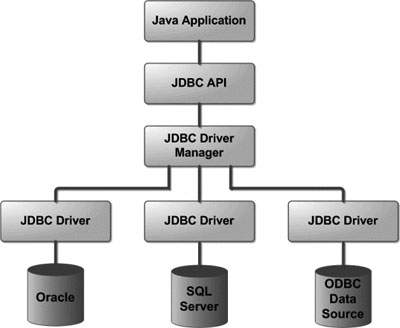JDBC入门学习
Introduction
What's JDBC
JDBC stands for Java Database Connectivity, which is a standard Java API for database-independent connectivity between the Java programming language and a wide range of databases.
JDBC library (includes APIs)的主要用途包括
Making a connection to a database. 连接数据库
Creating SQL or MySQL statements. 创建SQL或者MySQL语句
Executing SQL or MySQL queries in the database. 执行SQL或者MySQL查询
Viewing & Modifying the resulting records. 查看或者修改结果
JDBC架构
JDBC支持两层或者三层处理逻辑。但是一般,包括两层结构
JDBC API: This provides the application-to-JDBC Manager connection.
JDBC Driver API: This supports the JDBC Manager-to-Driver Connection.

JDBC drivers实现了JDBC APIs定义的接口。
JDBC连接
连接JDBC通常有四个简单的步骤
Import JDBC Packages: Add import statements to your Java program to import required classes in your Java code.
Register JDBC Driver: This step causes the JVM to load the desired driver implementation into memory so it can fulfill your JDBC requests.
Database URL Formulation: This is to create a properly formatted address that points to the database to which you wish to connect.
Create Connection Object: Finally, code a call to the DriverManagerobject's getConnection( ) method to establish actual database connection.
注册JDBC driver
注册JDBC driver有两种方法:
Approach 1: Class.forName() 自动将driver相关class加载到内存
try {
Class.forName("oracle.jdbc.driver.OracleDriver");
}
catch(ClassNotFoundException ex) {
System.out.println("Error: unable to load driver class!");
System.exit(1);
}
Approach 2: DriverManager.registerDriver() 如果使用的是 non-JDK compliant JVM
try {
Driver myDriver = new oracle.jdbc.driver.OracleDriver();
DriverManager.registerDriver( myDriver );
}
catch(ClassNotFoundException ex) {
System.out.println("Error: unable to load driver class!");
System.exit(1);
}
Database URL formulation
加载完driver之后,可以用DriverManager.getConnection()建立连接。
下面是常用数据库与connection URL的映射表
| RDBMS | JDBC driver name | URL format |
|---|---|---|
| MySQL | com.mysql.jdbc.Driver | jdbc:mysql://hostname/ databaseName |
| ORACLE | oracle.jdbc.driver.OracleDriver | jdbc:oracle:thin:@hostname:port Number:databaseName |
| DB2 | COM.ibm.db2.jdbc.net.DB2Driver | jdbc:db2:hostname:port Number/databaseName |
| Sybase | com.sybase.jdbc.SybDriver | jdbc:sybase:Tds:hostname: port Number/databaseName |
JDBC statement,PreparedStatement & CallableStatement
根据不同的需用,可以选择不同的statement接口。
| Interfaces | Recommended Use |
|---|---|
| Statement | Use for general-purpose access to your database. Useful when you are using static SQL statements at runtime. The Statement interface cannot accept parameters. |
| PreparedStatement | Use when you plan to use the SQL statements many times. The PreparedStatement interface accepts input parameters at runtime. |
| CallableStatement | Use when you want to access the database stored procedures. The CallableStatement interface can also accept runtime input parameters. |
Statement
创建statement
Statement stmt = null;
try {
stmt = conn.createStatement( );
. . .
}
catch (SQLException e) {
. . .
}
finally {
. . .
}
执行statement
创建完statement object之后,可以用来执行SQL语句
boolean execute (String SQL): Returns a boolean value of true if a ResultSet object can be retrieved; otherwise, it returns false. Use this method to execute SQL DDL statements or when you need to use truly dynamic SQL.
int executeUpdate (String SQL): Returns the number of rows affected by the execution of the SQL statement. Use this method to execute SQL statements for which you expect to get a number of rows affected - for example, an INSERT, UPDATE, or DELETE statement.
ResultSet executeQuery (String SQL): Returns a ResultSet object. Use this method when you expect to get a result set, as you would with a SELECT statement.
关闭statement
如果close connection节省数据库资源一样,close statement可以确保资源的合理回收。
Statement stmt = null;
try {
stmt = conn.createStatement( );
. . .
}
catch (SQLException e) {
. . .
}
finally {
stmt.close();
}
JDBC 批处理
批处理(batch processing)允许一次执行多条SQL语句。由于JDBC drivers并没有要求实现这个功能,因此使用前先用 DatabaseMetaData.supportsBatchUpdates() 检测目标数据库是否支持批处理。
Statement对象的批处理
Create a Statement object using either createStatement() methods.
Set auto-commit to false using setAutoCommit().
Add as many as SQL statements you like into batch using addBatch()method on created statement object.
Execute all the SQL statements using executeBatch() method on created statement object.
Finally, commit all the changes using commit() method.
// Create statement object
Statement stmt = conn.createStatement(); // Set auto-commit to false
conn.setAutoCommit(false); // Create SQL statement
String SQL = "INSERT INTO Employees (id, first, last, age) " +
"VALUES(200,'Zia', 'Ali', 30)";
// Add above SQL statement in the batch.
stmt.addBatch(SQL); // Create one more SQL statement
String SQL = "INSERT INTO Employees (id, first, last, age) " +
"VALUES(201,'Raj', 'Kumar', 35)";
// Add above SQL statement in the batch.
stmt.addBatch(SQL); // Create one more SQL statement
String SQL = "UPDATE Employees SET age = 35 " +
"WHERE id = 100";
// Add above SQL statement in the batch.
stmt.addBatch(SQL); // Create an int[] to hold returned values
int[] count = stmt.executeBatch(); //Explicitly commit statements to apply changes
conn.commit();
PreparedStatement对象的批处理
// Create SQL statement
String SQL = "INSERT INTO Employees (id, first, last, age) " +
"VALUES(?, ?, ?, ?)"; // Create PrepareStatement object
PreparedStatemen pstmt = conn.prepareStatement(SQL); //Set auto-commit to false
conn.setAutoCommit(false); // Set the variables
pstmt.setInt( 1, 400 );
pstmt.setString( 2, "Pappu" );
pstmt.setString( 3, "Singh" );
pstmt.setInt( 4, 33 );
// Add it to the batch
pstmt.addBatch(); // Set the variables
pstmt.setInt( 1, 401 );
pstmt.setString( 2, "Pawan" );
pstmt.setString( 3, "Singh" );
pstmt.setInt( 4, 31 );
// Add it to the batch
pstmt.addBatch(); //add more batches
.
.
.
.
//Create an int[] to hold returned values
int[] count = stmt.executeBatch(); //Explicitly commit statements to apply changes
conn.commit();
References
http://www.tutorialspoint.com/jdbc/jdbc-where-clause.htm
http://stackoverflow.com/questions/2839321/connect-java-to-a-mysql-database
JDBC入门学习的更多相关文章
- mysql的jdbc入门学习小结
转自:专注JavaWeb开发 http://www.javaweb1024.com/data/MySQL/2015/04/25/618.html 一.jdbc基本概念jdbc : Java Datab ...
- MyBatis入门学习教程-使用MyBatis对表执行CRUD操作
上一篇MyBatis学习总结(一)--MyBatis快速入门中我们讲了如何使用Mybatis查询users表中的数据,算是对MyBatis有一个初步的入门了,今天讲解一下如何使用MyBatis对use ...
- MyBatis入门学习(二)
在MyBatis入门学习(一)中我们完成了对MyBatis简要的介绍以及简单的入门小项目测试,主要完成对一个用户信息的查询.这一节我们主要来简要的介绍MyBatis框架的增删改查操作,加深对该框架的了 ...
- Jdbc入门
JDBC入门 l 导jar包:驱动! l 加载驱动类:Class.forName(“类名”); l 给出url.username.password,其中url背下来! l 使用DriverMa ...
- JDBC 接口学习
说明:文章所有内容皆选自实验楼教程[JDBC 入门教程],想要学习更多JDBC,可以点击教程进行学习~ JDBC 简介 JDBC 的全称是 Java Database Connectivity,叫做 ...
- day17(JDBC入门&jdbcUtils工具介绍)
day17 JDBC整体思维导图 JDBC入门 导jar包:驱动! 加载驱动类:Class.forName("类名"); 给出url.username.password,其中url ...
- Mybatis基础入门学习
Mybatis基础入门学习 mybatis架构分析 搭建测试mybatis架构 )下载并导入mybatis3.2.7.jar(架构),mysql-connector-java-5.1.7-bin.ja ...
- JDBC的学习 3-1
JDBC的学习 3-1 JDBC基本概念 快速入门 对JDBC中各个接口和类详解 JDBC : 概念 :Java DateBase Connectivity java数据库连接,Java语言操作数据库 ...
- vue入门学习(基础篇)
vue入门学习总结: vue的一个组件包括三部分:template.style.script. vue的数据在data中定义使用. 数据渲染指令:v-text.v-html.{{}}. 隐藏未编译的标 ...
随机推荐
- 1-web应用之LAMP源码环境搭建
目录 一.LAMP环境的介绍 1.LAMP环境的重要性 2.LAMP组件介绍 二.Apache源码安装 1.下载Apache以及相关依赖包 2.安装Apache以及相关 ...
- spring 定时任务@Scheduled
1.配置文件 <?xml version="1.0" encoding="UTF-8"?> <beans xmlns="http:/ ...
- jQuery.ajaxComplete() 函数详解
ajaxComplete()函数用于设置当AJAX请求完成(无论成功或失败)时执行的回调函数. 这是一个全局AJAX事件函数,用于为所有AJAX请求的ajaxComplete事件绑定事件处理函数.当A ...
- [LeetCode] Flip Game 翻转游戏之二
You are playing the following Flip Game with your friend: Given a string that contains only these tw ...
- 使用EXtjs6.2构建web项目
一.项目简介 众所周知ext是一款非常强大的表格控件,尤其是里边的grid为用户提供了非常多的功能,现在主流的还是用extjs4.0-4.2,但是更高一点的版本更加符合人的审美要求.因此,在今天咱们构 ...
- logback logback.xml常用配置详解 <filter>
<filter>: 过滤器,执行一个过滤器会有返回个枚举值,即DENY,NEUTRAL,ACCEPT其中之一.返回DENY,日志将立即被抛弃不再经过其他过滤器:返回NEUTRAL,有序列表 ...
- neo4j-jersey分嵌入式和服务式连接图形数据库
原文载自:http://blog.csdn.net/yidian815/article/details/12887259 嵌入式: 引入neo4j依赖 <dependency> <g ...
- 关于List的ConcurrentModificationException
对ArrayList的操作我们可以通过索引象来访问,也可以通过Iterator来访问,只要不对ArrayList结构上进行修改都不会造成ConcurrentModificationException, ...
- [转]Pythoin中的Lambda表达式
引用自:http://www.cnblogs.com/evening/archive/2012/03/29/2423554.html 在学习python的过程中,lambda的语法时常会使人感到困惑, ...
- Android环境变量配置
第一步: 把这些东西全部准备好!然后jdk怎么安装我相信大家都知道.安装好jdk之后,我们来配置环境变量. 我的电脑—右键—属性—高级系统设置—环境变量 JAVA_HOME环境变量.它指向jdk的安装 ...
